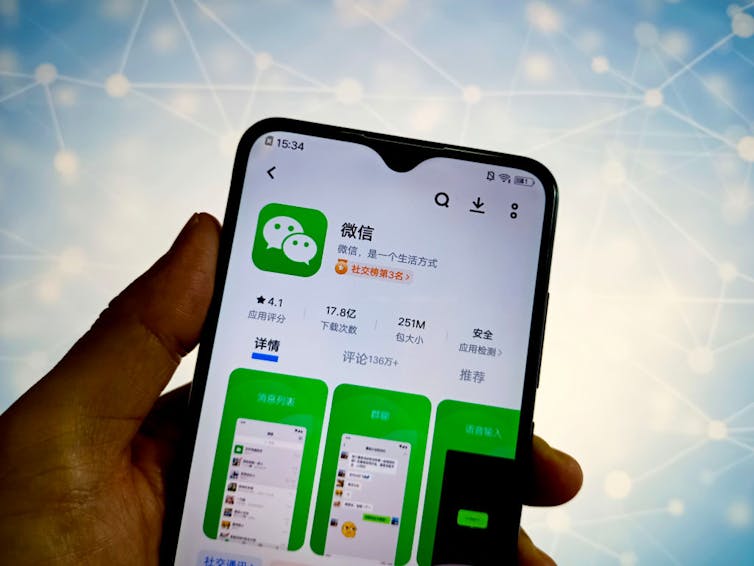BY Kristen Schiele, University of Southern California
Elon Musk’s recent rebranding of Twitter as X is a step toward the CEO’s goal of developing an “everything app.” Musk’s vision is for X to mark the spot for all your digital needs – to chat with your friends, order groceries, watch videos and manage your finances, all on one platform.
His recent announcement might have left you wondering what an everything app is and whether you need really one. If everything apps are so great, why isn’t there one that’s widely used in the U.S. already?
As someone who studies how consumers use social media and what that means for digital marketing, I find the idea of an everything app intriguing. I think that an everything app has the potential to be widely adopted in the U.S. if it’s well designed and is valuable to its users. But there are lots of obstacles standing in the way of success – from data privacy concerns to building a larger user base.
What is an everything app?
An everything app, also known as a “super app,” provides a wide range of features – from social networking to online shopping and financial services. Essentially it’s a fusion of many apps you may often use, like Instagram, Uber, WhatsApp and PayPal.
The intended goal of an everything app is to simplify daily tasks by saving time and effort needed to use multiple platforms. Through partnerships with third-party servicers, everything apps create an ecosystem where users can switch between different tasks without having to leave the app or install any others on their devices.


Future Publishing/Future Publishing via Getty Images
Over the past few years, everything apps have gained popularity, particularly in some Asian countries, as users appreciate the increased efficiency and convenience of having all their contacts and favorite app features in the same place.
WeChat, known as Weixin in China, is considered one of the first successful everything apps. This multifunctional app offers communication services – messaging, calling and social media – as well as many financial services, like mobile payment for peer-to-peer transactions and WeChat Pay, which helps users manage bill payments and investments.
WeChat’s widespread popularity has transformed the way people in China communicate and conduct daily tasks. It has become an essential app for over 1 billion users and is an important marketing tool for many businesses.
Other examples of everything apps include Line in Japan and KakaoTalk in South Korea.
Privacy and security concerns
But the very thing that makes an everything app so appealing – putting everything in one place – is also a source of concern.
In order to function, an everything app needs to collect an extensive amount of data, including your personal information, your contact lists, your location and even how much you use the app.
Users are often not fully aware of how much of their data is collected and shared. When was the last time you carefully read through an app’s privacy policy? Some apps retain data for extended periods of time, even after a user has abandoned the app. Storing so much data in one place also increases the risk of a breach.
This extensive amount of tracking raises concerns about surveillance and user profiling, especially in countries with weak data protection laws. An everything app may be subject to government surveillance and data requests, further compromising users’ privacy. The app may also share this data with third-party service providers.
WeChat has been criticized for its data collection, political censoring and surveillance. Research has found that WeChat complies with government and police requests for data and information, so it can be used as a surveillance tool and for content censorship. Some countries have banned or are considering banning WeChat because of security concerns.
To address privacy concerns, I believe everything apps need to be transparent about their data collection practices. Users will be more open to embracing an everything app if they have the means to manage their privacy settings and delete their data.
Building a user base
It’s difficult to predict whether an app will take off. Advertising can motivate someone to download an app, but word of mouth is often far more effective. As you see more of your friends join a specific social media platform, you might be more tempted to download that app so you don’t miss out.


Xavier Lorenzo/Moment via Getty Images
Good security and privacy aren’t enough to build a strong user base – the app also needs to be easy to use. While the goal of the app is to put everything in one place, some users may feel alienated by a confusing or cluttered interface. Familiar icons, navigation and terminology can help users feel more comfortable and encourage them to use the app more.
In addition, an app with so many features requires lots of resources, like storage and processing power. Users with older mobile devices may be frustrated with slow loading times or buggy responsiveness, pushing them away from using an everything app.
There’s also the possibility that some U.S. users may not buy into the idea of an everything app. Although integrating finances into WeChat has been successful in China, where more than 84% of adults use mobile payments, it may not be as easily accepted in the U.S., where less than 33% of adults use mobile payments and previous attempts to connect social features with finances have failed. Just look at Snapchat, which shut down Snapcash in 2018. Even if developers managed to build the perfect everything app, there may be some people who just won’t want it – especially if that app is held by a private company subject to the whims of a controversial owner like Musk.
So where does this leave X? The app has a long way to go before it becomes an everything app, and Musk’s many changes to the platform already have users jumping ship in search of a Twitter substitute. But, whether it’s X or not, I think there’s certainly room in the U.S. for an everything app to move in.![]()
![]()
Kristen Schiele, Associate Professor of Clinical Marketing, University of Southern California
This article is republished from The Conversation under a Creative Commons license. Read the original article.

1 Comment
Pingback: Why Elon Musk Won't Succeed In Turning X Into An ‘Everything App' - News Online | Concnews